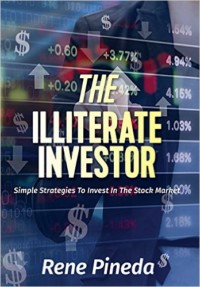Title: The Illiterate Investor
Author: Rene Pineda
Publisher: Tell Well
ISBN: 978-1773023779
Pages: 124
Genre: Nonfiction Business (trading and investing)
Reviewed by: J.W. Bankston
Buy Book on AmazonPacific Book Review
In a world of money making schemes and dreams, cogent advice is rare. That’s why books like Rene Pineda’s “The Illiterate Investor” are so welcome. Pineda’s book doesn’t rely on complex algorithms. Instead, it provides simple, straight forward advice for neophyte investors. Pineda also makes a compelling argument. He believes most people benefit by taking control of their investments instead of relying on fee-charging mutual funds and commission charging brokers. Pineda’s back story offers a subtle rebuke to anyone with a ready-made excuse for their own financial failings.
As Pineda explains, he arrived in the U.S. as an illegal immigrant from war torn El Salvador. His stints in the U.S. and Canada meant working “as many other Latinos do – – as a dishwasher, parking lot attendant and in other low paying jobs… workplace accidents, surgeries and the resulting debt led me to teach myself how to trade in the stock market.” His book collects the knowledge he gained as an unseasoned investor.
Even the market’s most casual observers are familiar with the “buy-and-hold” strategy popularized by Warren Buffett. These long-term investors purchase shares in undervalued companies with solid fundamentals. They then hold onto them for years, even decades, hoping the stocks increase in value. On the opposite end of the spectrum, day traders buy and selling shares, well, daily. They may hold a position for just minutes, hoping to profit from tiny, incremental movements in share price. It can be extraordinarily risky. Some view stock market investing as gambling. But the best investors resemble professional poker players who leverage training and talent in a game only partially driven by luck. Day trading is like betting on dice. As Pineda explains, most people make money from day trading by running schools promising profits in exchange for expensive tuition.
Pineda splits the difference between buy-and-hold and day-trading. The author is a swing trader. “By using swing trading, you can do one trade a day, and you are not required to trade every day, every week, or even every month,” he points out. “One very positive aspect of swing trading is that your risk of becoming addicted to trading is less likely than day trading, where you are on edge every single day.” I assume the title is tongue in cheek. If the target audience were truly illiterate, the book would be illustrated. Perhaps “The Ignorant Investor,” is more on point. After all, as investors wade through an endless stream of digital information it is impossible not to feel ignorant. Unfortunately, the author’s overly casual advice sometimes reduces his credibility: “One broker that you can use is called Sure Trader,” he says. “I am in no way recommending [it]…it is just a name that came into my mind.” Worse, in a book so “of the moment” that it references Brexit, the author has surprisingly little to say about how artificially low interest rates affect the stock market. In a recent Wall Street Journal editorial, Morgan Stanley’s chief global strategist pointed out that a composite index for stocks, bonds and homes reveals “their combined valuations have never been higher in 50 years.” Historically, when bubbles burst it can take years for them to recover.
Regardless of what investment philosophy the reader ultimately chooses, “The Illiterate Investor” offers solid information on everything from setting up a trading account to utilizing social media to determine trends. Perhaps best of all, the author provides a list of other helpful books and a glossary of terms. For these reasons, this book is an excellent introduction to investing and can also serve as a refresher for those who want to reenter the stock market.



Follow Us